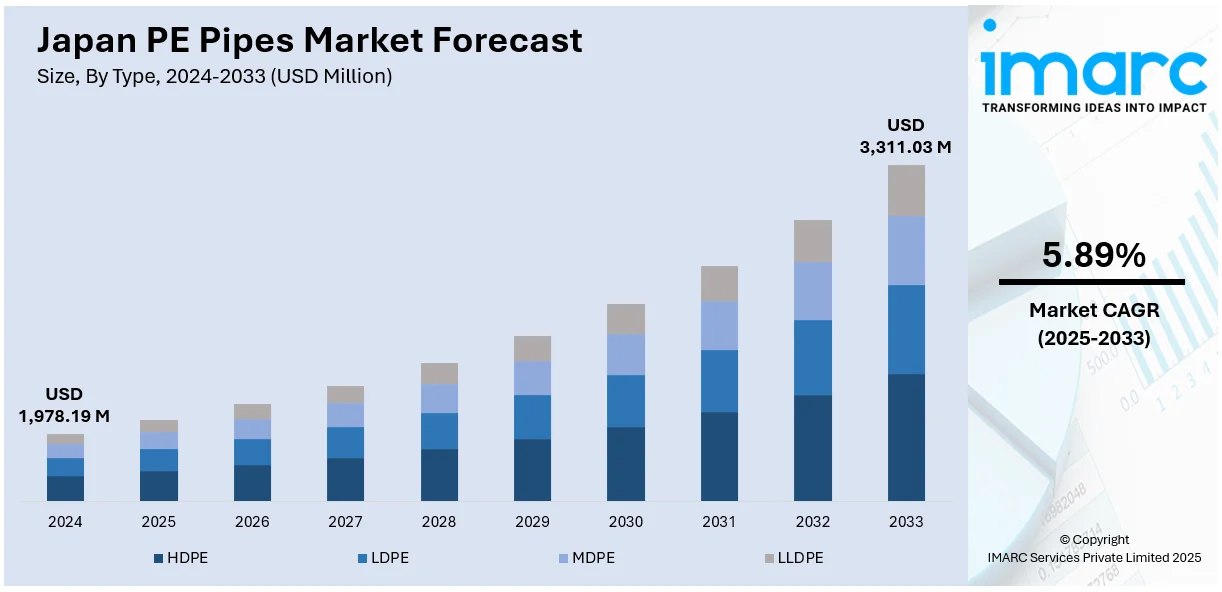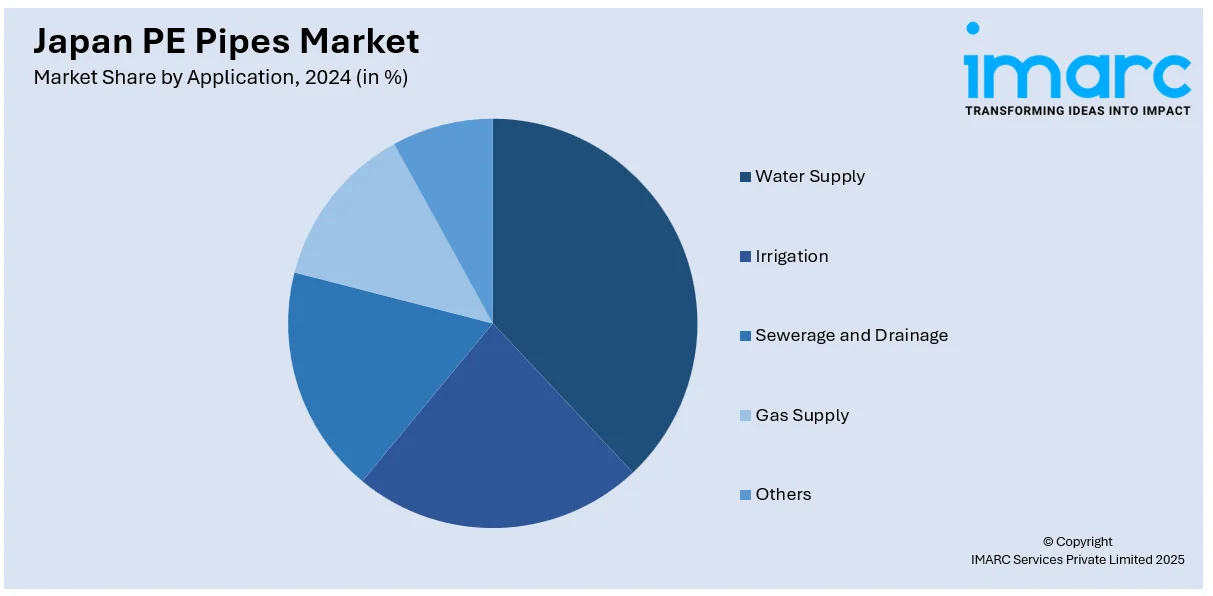
Japan PE Pipes Market Size, Share, Trends and Forecast by Type, Application, and Region, 2025-2033
Japan PE Pipes Market Overview:
The Japan PE pipes market size reached USD 1,978.19 Million in 2024. Looking forward, IMARC Group expects the market to reach USD 3,311.03 Million by 2033, exhibiting a growth rate (CAGR) of 5.89% during 2025-2033. The market is driven by the growing infrastructure upgrades, increasing demand for durable and corrosion-resistant piping, and government support for sustainable construction. Additionally, the rise of smart technologies and eco-conscious practices is pushing manufacturers to innovate, offering efficient, long-lasting, and environmentally friendly piping solutions across various sectors.
|
Report Attribute
|
Key Statistics
|
|---|---|
|
Base Year
|
2024 |
|
Forecast Years
|
2025-2033
|
|
Historical Years
|
2019-2024
|
| Market Size in 2024 | USD 1,978.19 Million |
| Market Forecast in 2033 | USD 3,311.03 Million |
| Market Growth Rate 2025-2033 | 5.89% |
Japan PE Pipes Market Trends:
Infrastructure Modernization and Pipeline Replacement
Japan's aging water and gas infrastructure is driving the need for modern pipeline solutions, with approximately 20,000 accidents involving water pipes occurring annually due to the short lifespan of traditional systems, which last around 40 years. Polyethylene (PE) pipes are increasingly preferred due to their flexibility, corrosion resistance, and extended service life, making them an ideal solution for replacing outdated metal and concrete piping. Their lightweight design simplifies transportation and installation, reducing labor costs and time. This trend is further supported by government initiatives aimed at upgrading essential services and ensuring the longevity of infrastructure. Contractors and developers are prioritizing materials like PE pipes that reduce long-term maintenance needs, contributing to more resilient infrastructure. This shift is key to modernizing Japan’s pipeline systems in both urban and rural areas while future-proofing critical public utilities for years to come.

Focus on Sustainability and Eco-Friendly Solutions
Environmental consciousness is a major influence in Japan’s PE pipes market. Manufacturers are shifting towards sustainable production methods and eco-friendly materials to meet strict environmental standards. There’s a growing interest in recyclable and reusable PE piping solutions, aiming to reduce plastic waste and support a circular economy. Companies are investing in research and innovation to create low-impact alternatives while maintaining performance and durability. This trend aligns with broader societal values in Japan that emphasize harmony with nature and responsible resource usage. As both public and private sectors adopt greener building practices, demand is increasing for PE pipes that align with eco-certifications and sustainable development goals.
Digitalization and Smart Infrastructure Integration
Digital technology is reshaping how PE pipes are manufactured, installed, and maintained in Japan. With the rise of smart cities and intelligent infrastructure, PE piping systems are being designed to integrate with sensors and IoT devices. These systems allow for real-time monitoring of flow rates, pressure, and potential faults, which helps utilities optimize operations and prevent service disruptions. Digital tools also assist in precision installation, improving accuracy and reducing waste. This shift toward digitalization is helping utility providers extend the lifespan of infrastructure while improving efficiency. The trend reflects Japan’s broader commitment to technological innovation and its application across various industries, including construction and utilities.
Japan PE Pipes Market Segmentation:
IMARC Group provides an analysis of the key trends in each segment of the market, along with forecasts at the region level for 2025-2033. Our report has categorized the market based on type and application.
Type Insights:
- HDPE
- LDPE
- MDPE
- LLDPE
The report has provided a detailed breakup and analysis of the market based on the type. This includes HDPE, LDPE, MDPE, and LLDPE.
Application Insights:

- Water Supply
- Irrigation
- Sewerage and Drainage
- Gas Supply
- Others
A detailed breakup and analysis of the market based on the application have also been provided in the report. This includes water supply, irrigation, sewerage and drainage, gas supply, and others.
Regional Insights:
- Kanto Region
- Kansai/Kinki Region
- Central/ Chubu Region
- Kyushu-Okinawa Region
- Tohoku Region
- Chugoku Region
- Hokkaido Region
- Shikoku Region
The report has also provided a comprehensive analysis of all the major regional markets, which include Kanto, Kansai/Kinki, Central/ Chubu, Kyushu-Okinawa, Tohoku, Chugoku, Hokkaido, and Shikoku Region.
Competitive Landscape:
The market research report has also provided a comprehensive analysis of the competitive landscape. Competitive analysis such as market structure, key player positioning, top winning strategies, competitive dashboard, and company evaluation quadrant has been covered in the report. Also, detailed profiles of all major companies have been provided.
Japan PE Pipes Market News:
- In March 2025, Japan issued its first significant tender under the hydrogen hubs programme, providing ¥5.7 billion ($38 million) worth of subsidies for front-end engineering and design (FEED) of common infrastructure such as pipelines and storage. The initiative aims to support hydrogen production and import clusters. While bidding began on 5 March, funding approval is still pending in parliament. The government will cover up to 50% of FEED costs for selected projects.
- In January 2025, SABIC introduced VESTOLEN P9421, a new random polypropylene pipe solution offering high thermal stability and durability under high pressure and temperature. Designed for both hot and cold drinking water systems, it ensures long service life and reliability. Tailored for Saudi Arabia’s domestic piping market, this innovation reflects SABIC’s commitment to quality and collaboration, providing a versatile, high-performance material for a wide range of pipe applications across the value chain.
Japan PE Pipes Market Report Coverage:
| Report Features | Details |
|---|---|
| Base Year of the Analysis | 2024 |
| Historical Period | 2019-2024 |
| Forecast Period | 2025-2033 |
| Units | Million USD |
| Scope of the Report |
Exploration of Historical Trends and Market Outlook, Industry Catalysts and Challenges, Segment-Wise Historical and Future Market Assessment:
|
| Types Covered | HDPE, LDPE, MDPE, LLDPE |
| Applications Covered | Water Supply, Irrigation, Sewerage and Drainage, Gas Supply, Others |
| Regions Covered | Kanto Region, Kansai/Kinki Region, Central/ Chubu Region, Kyushu-Okinawa Region, Tohoku Region, Chugoku Region, Hokkaido Region, and Shikoku Region |
| Customization Scope | 10% Free Customization |
| Post-Sale Analyst Support | 10-12 Weeks |
| Delivery Format | PDF and Excel through Email (We can also provide the editable version of the report in PPT/Word format on special request) |
Key Questions Answered in This Report:
- How has the Japan PE pipes market performed so far and how will it perform in the coming years?
- What is the breakup of the Japan PE pipes market on the basis of type?
- What is the breakup of the Japan PE pipes market on the basis of application?
- What is the breakup of the Japan PE pipes market on the basis of region?
- What are the various stages in the value chain of the Japan PE pipes market?
- What are the key driving factors and challenges in the Japan PE pipes market?
- What is the structure of the Japan PE pipes market and who are the key players?
- What is the degree of competition in the Japan PE pipes market?
Key Benefits for Stakeholders:
- IMARC’s industry report offers a comprehensive quantitative analysis of various market segments, historical and current market trends, market forecasts, and dynamics of the Japan PE pipes market from 2019-2033.
- The research report provides the latest information on the market drivers, challenges, and opportunities in the Japan PE pipes market.
- Porter's five forces analysis assist stakeholders in assessing the impact of new entrants, competitive rivalry, supplier power, buyer power, and the threat of substitution. It helps stakeholders to analyze the level of competition within the Japan PE pipes industry and its attractiveness.
- Competitive landscape allows stakeholders to understand their competitive environment and provides an insight into the current positions of key players in the market.
Need more help?
- Speak to our experienced analysts for insights on the current market scenarios.
- Include additional segments and countries to customize the report as per your requirement.
- Gain an unparalleled competitive advantage in your domain by understanding how to utilize the report and positively impacting your operations and revenue.
- For further assistance, please connect with our analysts.
 Request Customization
Request Customization
 Speak to an Analyst
Speak to an Analyst
 Request Brochure
Request Brochure
 Inquire Before Buying
Inquire Before Buying




.webp)




.webp)












